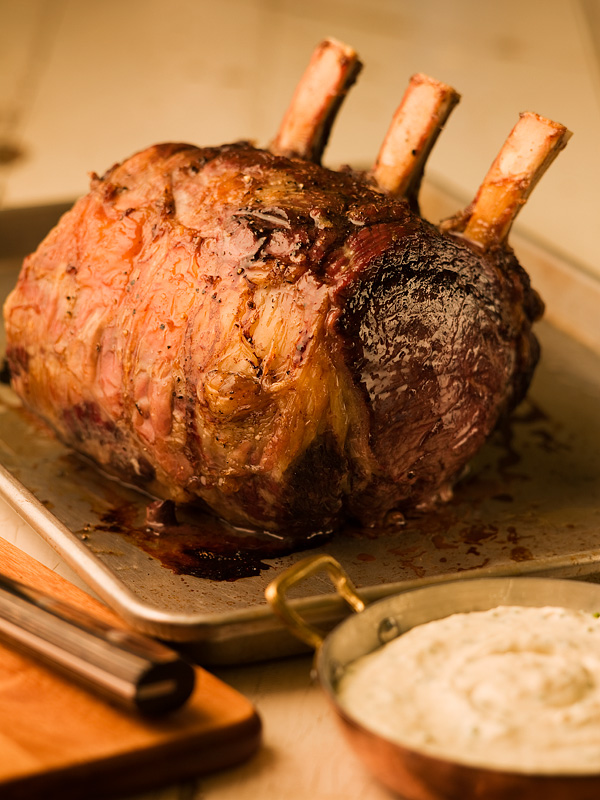Nothing gets your guests’ attention at the table, or your attention in the kitchen, like spending nearly a hundred dollars on a piece of meat, but a prime rib doesn’t have to be intimidating. Instead, impress yourself in your own kitchen by cooking it the way the pros do: with a two-step heating process and a few more dollars invested in an accurate meat thermometer.
Yield: Serves 8 - 10
Ingredients
one 3- or 4-bone standing prime rib roast, about 7 pounds
lots sea salt and freshly ground pepper
1 cup sour cream
1/2 cup prepared horseradish
2 tablespoons thinly sliced fresh chives
Procedure
Place a roasting pan in the lower third of the oven and preheat it to 450 °F (230 °C).
Thoroughly dry the meat by patting it with paper towels. This will help it brown quickly by getting rid of any surface moisture. Rub the surface of the meat with lots of coarse sea salt and freshly ground black pepper.
To sear the top surface, place the roastrib side upin a roasting pan and roast for 30 minutes. Flip the roast over and turn the oven down to 300 °F (150 °C). Continue roasting until an instant-read thermometer placed in the thickest part of the meat reads 135 °F to 140 °F (57 °C to 60 °C), about 3 hours in total. This will give you a perfect medium-rare to medium roast. For medium, wait until the thermometer reads 150 °F (65 °C), about 30 minutes more.
Remove the roast from the oven and rest it in a warm place loosely covered with several layers of foil for 15 to 20 minutes. Its stressed-out fibres will relax and re-absorb the juices that concentrate under great pressure in the centre of the meat during roasting. The internal temperature will slowly rise another 5 °F to 10 °F (20 °C to 23 °C) or so. This is known as carryover cooking and is factored into the doneness judgment above.
Meanwhile, whisk together the sour cream, horseradish and chives. Once the meat has rested, slice away and serve with the horseradish sauce.
Ask your butcher for a roast from the “small” end of the larger full prime rib; the end nearest the loin is prized for its full shape and tender flavour. Be sure to specify that the “chine” bone be removed; it’s part of the backbone and will give you trouble slicing the meat. If the roast is “tied,” it will roast more evenly, but it’s not absolutely critical.
Roasting large cuts of meat requires a balance of cooking methods. A high-heat roast will yield the beautiful crisp outside that makes prime rib so tasty. But, by the time the inside cooks through, the high heat will lead to a burnt exterior. The high heat also stresses the meat, shrinking it and squeezing out the vital moisture. A low-heat roast, while slower to cook, will result in much less shrinkage and a more even doneness. Unfortunately, slow heat won’t brown the outside as nicely as high, fast heat. The solution? A combination.


